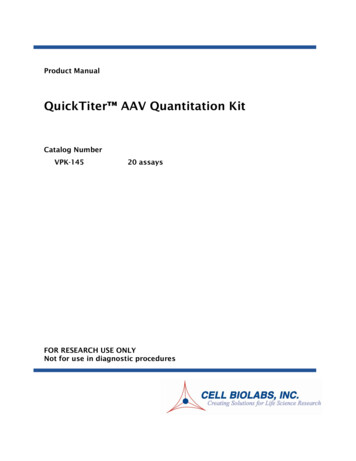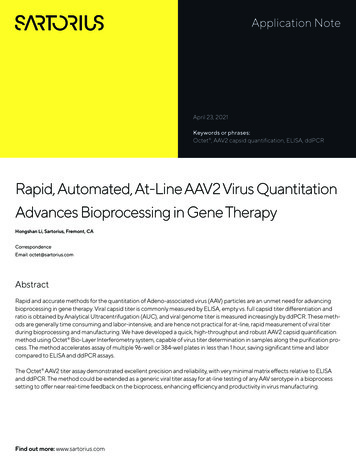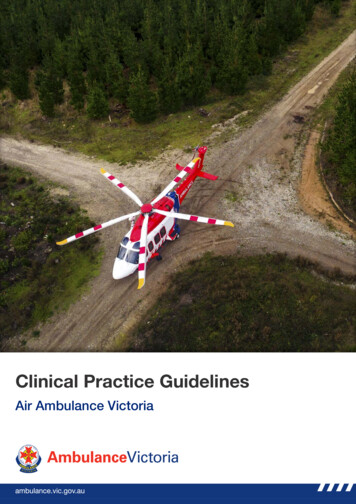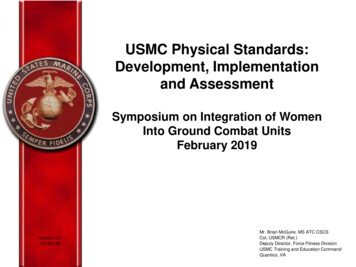
Transcription
Product ManualQuickTiter AAV Quantitation KitCatalog NumberVPK-14520 assaysFOR RESEARCH USE ONLYNot for use in diagnostic procedures
IntroductionViral gene delivery systems include vectors developed from retrovirus (RV), adenovirus (AdV),adeno-associated virus (AAV), lentivirus (LV), and herpes simplex virus (HSV). AAV belongs to thefamily of Parvoviridae, a group of viruses among the smallest of single-stranded and non-envelopedDNA viruses. There are eight different AAV serotypes reported to date.Recombinant AAV-2 is the most common serotype used in gene delivery, and it can be produced athigh titers with a helper virus or Cell Biolabs’ AAV Helper-Free System. AAV-2 can infect bothdividing and non-dividing cells and can be maintained in the human host cell, creating the potential forlong-term gene transfer. Because AAV-2 is a naturally defective virus, requiring provision of severalfactors in trans configuration for productive infection, it is considered the safest viral vector to use.Recently a new vector, AAV-DJ, was developed using DNA family shuffling to create a hybrid capsidfrom 8 different AAV serotypes, resulting in a vector with significantly higher in vitro infection ratesacross a variety of cells and tissues.Recombinant AAV-2 and AAV-DJ vectors can be purified by CsCl gradient ultracentrifugation,iodixanol discontinuous gradient ultracentrifugation, or Cell Biolabs’ ViraBind AAV PurificationKit.A particular challenge in the delivery of a gene by a viral vector is the accurate measurement of virustiter. Traditionally, AAV particles are measured by DNA dot blot or similar approaches. Thesemethods are time-consuming and suffer from a high degree of inter-assay variability. For highlypurified virus samples, an optical absorbance at 260 nm has been used to estimate the total number ofvirus particles. However this method cannot be used in an unpurified viral supernatant, because othercomponents it contains can contribute to the optical absorbance of 260 nm. An ELISA method hasbeen developed by using antibody that only reacts with AAV intact particles; however, this methodmeasures all AAV particles including the ones lacking genomic DNA.Cell Biolabs’ proprietary QuickTiter AAV Quantitation Kit does not involve cell infection; instead itspecifically measures the viral nucleic acid content of purified viruses or unpurified viral supernatantsample (See Assay Principle). The kit is especially useful for determining the supernatant titer beforethe purification step. The kit has a detection sensitivity limit of 1 X 109 GC/mL (genome copy/mL) forunpurified AAV-2 or AAV-DJ supernatants, or 5 X 1010 GC/mL for purified AAV sample from anyserotype, which is sufficient for mid or high-titer AAV samples. The entire procedure takes about 4hours for unpurified supernatant or about 30 minutes for purified AAV. Each kit provides sufficientquantities to perform up to 20 tests for unpurified AAV-2 or AAV-DJ samples generated from theAAV Helper-Free System.QuickTiter AAV Quantitation Kit provides an efficient system for rapid quantitation of AAV titerfor both viral supernatant and purified virus.2
Assay Principle3
Related Products1. AAV-100: 293AAV Cell Line2. VPK-140: ViraBind AAV Purification Kit3. VPK-141: ViraBind AAV Purification Mega Kit4. AAV-200: ViraDuctin AAV Transduction Kit5. VPK-109: QuickTiter Adenovirus Titer Immunoassay Kit6. VPK-110: QuickTiter Adenovirus Titer ELISA Kit7. VPK-106: QuickTiter Adenovirus Quantitation Kit8. VPK-112: QuickTiter Lentivirus Quantitation Kit9. VPK-120: QuickTiter Retrovirus Quantitation KitKit Components1. ViraBind AAV Reagent A (Part No. 314001): One 0.3 mL tube.2. ViraBind AAV Reagent B (Part No. 314002): One 1.5 mL tube.3. QuickTiter AAV Capture Matrix (Part No. 314501): One 1 mL tube.4. QuickTiter AAV Wash Solution (5X) (Part No. 314502): One 10 mL bottle.5. QuickTiter Solution C (10X) (Part No. 314503): One 5 mL bottle.6. CyQuant GR Dye (400X) (Part No. 105101): One 50 µL tube.7. QuickTiter AAV DNA Standard (Part No. 314504): One 500 µL tube containing 100 µg/mLAAV DNA Standard.Materials Not Supplied1. AAV Helper-Free System2. HEK 293 cells and cell culture growth medium3. Cell culture centrifuge4. 1X TE (10 mM Tris, pH 7.5, 1 mM EDTA)5. Fluorescence Plate ReaderStorageStore ViraBind AAV Reagent B at room temperature and all other kit components at 4ºC.Safety ConsiderationsRemember that you will be working with samples containing infectious virus. Follow therecommended NIH guidelines for all materials containing BSL-2 organisms.4
Preparation of Reagents 1X QuickTiter AAV Wash Solution: Prepare a 1X QuickTiter AAV Wash Solution bydiluting the provided 5X stock 1:5 in deionized water. Store the diluted solution at roomtemperature. 1X QuickTiter Solution C: Prepare a 1X QuickTiter Solution C by diluting the provided 10Xstock to 1X with 1X TE. Store the diluted solution at room temperature.Note: Only dilute the amount of QuickTiter Solution C needed to prepare the Standard Curveand unpurified samples. If purified AAV samples will be tested, the 10X QuickTiter Solution Cwill be used undiluted. 1X CyQuant GR Dye: Estimate the amount of 1X CyQuant GR Dye needed based on thenumber of assays including AAV DNA standard samples. Immediately before use, prepare a 1XCyQuant GR Dye by diluting the provided 400X stock 1:400 in 1X TE. For best results, thediluted solution should be used within 2 hrs of its preparation.Preparation of Standard Curve1. Create AAV DNA standards from 10 µg/mL, 5 µg/mL, 2.5 µg/mL, 1.25 µg/mL, 0 µg/mL (using1:2 serial dilutions).StandardTubes1234567891011121X QuickTiter Solution C(µL)905050505050505050505050100 μg/mL AAV DNAStandard (µL)1050 of Tube #150 of Tube #250 of Tube #350 of Tube #450 of Tube #550 of Tube #650 of Tube #750 of Tube #850 of Tube #950 of Tube #100AAV .0390.0200.01002. Transfer 10 µL of each dilution including blank to a microtiter plate suitable for reading on afluorometer. Add 90 µL of 1X CyQuant GR Dye to each of the wells containing the 10 µLsample. Read the plate with a fluorescence plate reader using a 480/520 nm filter set.Preparation of rAAV SamplesThe following procedure is suggested for one 15 cm dish or two 10 cm dishes and may be optimized tosuit individual needs. For best results please refer to your user manual for Cell Biolabs’ AAV Helper5
Free System or other system you are using. In general, each cell produces about 20,000 to 100,000viral particles under optimized conditions.1. Use HEK 293 cells that have been passaged 2-3 times prior to transfection. Culture these cellsuntil the monolayer is 70-80% confluent.2. Cotransfect cells with the pAAV-RC, pHelper and your expression construct according tomanufacturer’s manual.3. After 48-72 hrs, harvest the transfected cells plus culture medium in a conical tube andcentrifuge for 5 min at 3000 rpm to pellet the transfected cells. Resuspend the cell pellet in 2.5mL of serum-free DMEM.4. Subject the cell suspension to four rounds of freeze/thaw cycles by alternating the tubesbetween the dry ice-ethanol bath and the 37ºC water bath.5. Collect the AAV supernatant by centrifugation at 10,000 x g for 10 minutes. Discard the pellet.6. The viral supernatant can be stored at -80ºC or immediately titered or purified.Assay ProtocolI. Unpurified AAV-2 or AAV-DJ SamplesNote: The following procedure is written for quantitation of 1.0 mL of unpurified AAV-2 orAAV-DJ supernatant. For AAV samples that are less than 1.0 mL, add serum-free DMEM tothe final volume of 1.0 mL.1. Add 10 µL of ViraBind AAV Reagent A to 1.0 mL of viral supernatant, mixing well.2. Incubate for 30 minutes at 37ºC.3. Incubate ViraBind AAV Reagent B for 30-60 minutes at 37ºC to ensure Reagent B isdissolved. Add 50 µL of ViraBind AAV Reagent B to the viral supernatant pre-treated withViraBind AAV Reagent A, mixing well.4. Incubate for 30 minutes at 37ºC.5. Resuspend the QuickTiter AAV Capture Matrix by inverting and shaking. Add 50 µL ofmatrix to the virus supernatant.6. Mix the supernatant/matrix suspension at room temperature for 30 minutes on a shaker.7. Pellet the AAV Capture Matrix by centrifugation for 10 minutes at 1,000 rpm.8. Carefully remove the supernatant and wash the AAV Capture Matrix with 1.0 mL of 1XQuickTiter AAV Wash Solution. Pellet the AAV Capture Matrix by centrifugation for 5minutes at 1,000 rpm and carefully remove the supernatant.9. Repeat the wash step once and aspirate the final wash. To remove the last bit of liquid,centrifuge the tube again at 2000 rpm for 30 seconds, and remove remaining supernatant with asmall bore pipette tip to avoid disturbing the beads.10. Add 20 µL of 1X QuickTiter Solution C and mix with the beads by vortexing for 30 seconds.Incubate 1 hr at 75ºC. Spin down the beads at 12,000 rpm for 30 seconds.6
11. Transfer 10 µL supernatant to a microtiter plate suitable for fluorometer. Add 90 µL of freshlyprepared 1X CyQuant GR Dye to well(s) containing the 10 µL supernatant. Read the platewith a fluorescence plate reader using a 480/520 nm filter set.12. Calculate AAV titer based on the standard curve.II. Purified AAV Sample1. Mix 13.5 µL of purified AAV sample and 1.5 µL of 10X QuickTiter Solution C in a tube andincubate 1 hr at 75ºC. Spin briefly to collect condensation. Incubate 20 minutes at roomtemperature.2. Prepare a non-heated control sample by mixing 13.5 µL of the same purified AAV sample and1.5 µL of 10X QuickTiter Solution C in a tube.3. Transfer 10 µL of the mixtures including the non-heated control sample to a microtiter platesuitable for reading in a fluorometer. Add 90 µL of freshly prepared 1X CyQuant GR Dye toeach well containing the 10 µL supernatant. Read the plate with a fluorescence plate readerusing a 480/520 nm filter set.4. Calculate AAV titer based on the standard curve.Example of ResultsThe following figures demonstrate typical quantitation results. One should use the data below forreference only. This data should not be used to interpret actual 51001250150246810AAV DNA STD (ng)AAV DNA STD (ng)Figure 1: AAV-2 DNA Standard Curve. The QuickTiter AAV-2 DNA Standard was diluted asdescribed in the Assay Protocol. Fluorescence measurement was performed on a SpectraMax GeminiXS Fluorometer (Molecular Devices) with a 485/538 nm filter set and 530 nm cutoff.Calculation of AAV-2 Titer (Genome Copy (GC)/mL)1. Determine AAV-2 DNA amount:7
1) Calculate Net RFU (Relative Fluorescence Unit):Net RFU RFU (viral sample) – RFU (negative control corresponding to viral sample)2) Use the standard curve to determine the viral DNA amount of each unknown sample.2. Calculate Viral Titer:The average genome size of an AAV-2 is 5000 base, therefore:1 ng AAV-2 DNA (1x10-9) g / (5000 base x 330 g/base) X 6 x 1023 3.6 x 108 GC(a) For unpurified AAV-2 sample:Net RFU RFU (viral sample) – RFU (0 ng/mL standard)Titer (GC/mL) Dilution Factor X AAV-2 DNA (ng) X (3.6 x 108 GC/ng) X (20 µL/10 µL)1.0 mL(b) For purified AAV-2 sample:Net RFU RFU (viral sample) – RFU (non-heated control sample)Titer (GC/mL) Dilution Factor X AAV-2 DNA (ng) X (3.6 x 108 GC/ng) X (15 µL/13.5 µL)0.010 mLCalculation ExamplePurified AAV-2-GFP (ViraBind AAV Purification Kit): undiluted purified AAV-2-GFP wasused as described in Assay ProtocolNet RFU 54.6 – 3.3 51.3 or 28 ng of viral DNATiter (GC/mL) Dilution Factor X AAV-2 DNA (ng) X (3.6 x 108 GC/ng) X (15 µL/13.5 µL)0.010 mLTiter (GC/mL) 1 X 28 (ng) X (3.6 x 108 GC/ng) X (15 µL/13.5 µL) 1.12 X 1012 GC/mL0.010 mLReferences1. Rabinowitz, J, and Samulski, R. J. (1998) Curr. Opin. Biotechnol., 9, 470-475.2. Summer ford, C., and Samulski, R. J. (1999) Nat. Med., 5, 587-588.3. Clark, K., Liu, X., McGrath, J., and Johnson, P. (1999) Hum. Gene Ther., 10, 1031-1039.Recent Product Citations1. Hsieh, C.C. et al. (2022). Macrophage Distribution Affected by Virus-Encoded GranulocyteMacrophage Colony Stimulating Factor Combined with Lactate Oxidase. ACS Omega. doi:10.1021/acsomega.2c03213.2. Hayashi, Y. et al. (2022). Coagulation factors promote brown adipose tissue dysfunction andabnormal systemic metabolism in obesity. iScience. doi: 10.1016/j.isci.2022.104547.3. Yoshida, Y. et al. (2022). Differing impact of phosphoglycerate mutase 1-deficiency on brown andwhite adipose tissue. iScience. doi: 10.1016/j.isci.2022.104268.8
4. Xu, M. et al. (2022). The E3 ubiquitin-protein ligase Trim31 alleviates non-alcoholic fatty liverdisease by targeting Rhbdf2 in mouse hepatocytes. Nat Commun. 13(1):1052. doi: 10.1038/s41467022-28641-w.5. Kashihara, T. et al. (2022). YAP mediates compensatory cardiac hypertrophy through aerobicglycolysis in response to pressure overload. J Clin Invest. doi: 10.1172/JCI150595.6. Paiva, L. et al. (2021). Identification of peripheral oxytocin-expressing cells using systemicallyapplied cell-type specific adeno-associated viral vector. J Neuroendocrinol. doi:10.1111/jne.12970.7. Wahis, J. et al. (2021). Astrocytes mediate the effect of oxytocin in the central amygdala onneuronal activity and affective states in rodents. Nat Neurosci. doi: 10.1038/s41593-021-00800-0.8. Francisco, J. et al. (2021). AAV-mediated YAP expression in cardiac fibroblasts promotesinflammation and increases fibrosis. Sci Rep. 11(1):10553. doi: 10.1038/s41598-021-89989-5.9. Kwon, O.C. et al. (2021). SGK1 inhibition in glia ameliorates pathologies and symptoms inParkinson disease animal models. EMBO Mol Med. doi: 10.15252/emmm.202013076.10. Lebeau, P.F. et al. (2020). The loss-of-function PCSK9Q152H variant increases ER chaperonesGRP78 and GRP94 and protects against liver injury. J Clin Invest. doi: 10.1172/JCI128650.11. Kawaguchi, Y. et al. (2020). Endoplasmic reticulum chaperone BiP/GRP78 knockdown leads toautophagy and cell death of arginine vasopressin neurons in mice. Sci Rep. 10(1):19730. doi:10.1038/s41598-020-76839-z.12. Rai, R. et al. (2020). Targeted gene correction of human hematopoietic stem cells for the treatmentof Wiskott - Aldrich Syndrome. Nat Commun. 11(1):4034. doi: 10.1038/s41467-020-17626-2.13. Zeng, J. et al (2020). The Zika Virus Capsid Disrupts Corticogenesis by Suppressing DicerActivity and miRNA Biogenesis. Cell Stem Cell. S1934-5909(20)30350-7. doi:10.1016/j.stem.2020.07.012.14. Tang, Y. et al. (2020). Social touch promotes interfemale communication via activation ofparvocellular oxytocin neurons. Nat Neurosci. doi: 10.1038/s41593-020-0674-y.15. Zhu, J. et al. (2020). Preparation of a Bacteriophage T4-based Prokaryotic-eukaryotic Hybrid ViralVector for Delivery of Large Cargos of Genes and Proteins into Human Cells. Bio-protocol.10(07): e3573. doi: 10.21769/BioProtoc.3573.16. Wu, Z. et al. (2020). Gene therapy conversion of striatal astrocytes into GABAergic neurons inmouse models of Huntington's disease. Nat Commun. 11(1):1105. doi: 10.1038/s41467-020-148553.17. Zhang, H. et al. (2020). Vitamin D receptor targets hepatocyte nuclear factor 4α and mediatesprotective effects of vitamin D in nonalcoholic fatty liver disease. J Biol Chem. pii:jbc.RA119.011487. doi: 10.1074/jbc.RA119.011487.18. Xu, Y. et al. (2020). Diabetic nephropathy execrates epithelial-to-mesenchymal transition (EMT)via miR-2467-3p/Twist1 pathway. Biomed Pharmacother. 125:109920. doi:10.1016/j.biopha.2020.109920.19. Oser, M.G. et al. (2019). The KDM5A/RBP2 histone demethylase represses NOTCH signaling tosustain neuroendocrine differentiation and promote small cell lung cancer tumorigenesis. GenesDev. doi: 10.1101/gad.328336.119.20. Niranjan, N. et al. (2019). Sarcolipin overexpression impairs myogenic differentiation in Duchennemuscular dystrophy. Am J Physiol Cell Physiol. doi: 10.1152/ajpcell.00146.2019.21. Ferretti, V. et al. (2019). Oxytocin Signaling in the Central Amygdala Modulates EmotionDiscrimination in Mice. Curr Biol. pii: S0960-9822(19)30499-3. doi: 10.1016/j.cub.2019.04.070.9
22. Hasan, M.T. et al. (2019). A Fear Memory Engram and Its Plasticity in the Hypothalamic OxytocinSystem. Neuron. pii: S0896-6273(19)30386-1. doi: 10.1016/j.neuron.2019.04.029.23. Lee, S. et al. (2019). Anti-EpCAM-conjugated adeno-associated virus serotype 2 for systemicdelivery of EGFR shRNA: Its retargeting and antitumor effects on OVCAR3 ovarian cancer invivo. Acta Biomater. pii: S1742-7061(19)30287-9. doi: 10.1016/j.actbio.2019.04.044.24. Nakamura, M. et al. (2019). Glycogen Synthase Kinase-3α Promotes Fatty Acid Uptake andLipotoxic Cardiomyopathy. Cell Metab. pii: S1550-4131(19)30005-1. doi:10.1016/j.cmet.2019.01.005.25. Tseng, S.J. et al. (2018). Targeting Tumor Microenvironment by Bioreduction-ActivatedNanoparticles for Light-Triggered Virotherapy. ACS Nano. 12(10):9894-9902. doi:10.1021/acsnano.8b02813.26. Ikegami, R. et al. (2018). Gamma-Aminobutyric Acid Signaling in Brown Adipose TissuePromotes Systemic Metabolic Derangement in Obesity. Cell Rep. 24(11):2827-2837.e5. doi:10.1016/j.celrep.2018.08.024.27. Menon, R. et al. (2018). Oxytocin Signaling in the Lateral Septum Prevents Social Fear duringLactation. Curr Biol. 28(7):1066-1078.e6. doi: 10.1016/j.cub.2018.02.044.28. Wen, L. et al. (2018). Transient High Pressure in Pancreatic Ducts Promotes Inflammation andAlters Tight Junctions via Calcineurin Signaling in Mice. Gastroenterology. 155(4):1250-1263.e5.doi: 10.1053/j.gastro.2018.06.036.29. McGrady, N.R. et al. (2017). Upregulation of the endothelin A (ETA) receptor and its associationwith neurodegeneration in a rodent model of glaucoma. BMC Neurosci. 18(1):27. doi:10.1186/s12868-017-0346-3.30. Wang, P. et al. (2017). Tau interactome mapping based identification of Otub1 as Taudeubiquitinase involved in accumulation of pathological Tau forms in vitro and in vivo. ActaNeuropathol. doi:10.1007/s00401-016-1663-9.License InformationThis product is provided under an intellectual property license from Life Technologies Corporation.The purchase of this product conveys to the buyer the non-transferable right to use the purchasedproduct and components of the product only in research conducted by the buyer (whether the buyer isan academic or for-profit entity). The sale of this product is expressly conditioned on the buyer notusing the product or its components, or any materials made using the product or its components, in anyactivity to generate revenue, which may include, but is not limited to use of the product or itscomponents: (i) in manufacturing; (ii) to provide a service, information, or data in return for payment;(iii) for therapeutic, diagnostic or prophylactic purposes; or (iv) for resale, regardless of whether theyare resold for use in research. For information on purchasing a license to this product for purposesother than as described above, contact Life Technologies Corporation, 5791 Van Allen Way, CarlsbadCA 92008 USA or outlicensing@lifetech.com.WarrantyThese products are warranted to perform as described in their labeling and in Cell Biolabs literature when used inaccordance with their instructions. THERE ARE NO WARRANTIES THAT EXTEND BEYOND THIS EXPRESSEDWARRANTY AND CELL BIOLABS DISCLAIMS ANY IMPLIED WARRANTY OF MERCHANTABILITY ORWARRANTY OF FITNESS FOR PARTICULAR PURPOSE. CELL BIOLABS’ sole obligation and purchaser’sexclusive remedy for breach of this warranty shall be, at the option of CELL BIOLABS, to repair or replace the products.In no event shall CELL BIOLABS be liable for any proximate, incidental or consequential damages in connection with theproducts.10
Contact InformationCell Biolabs, Inc.7758 Arjons DriveSan Diego, CA 92126Worldwide: 1 858-271-6500USA Toll-Free: 1-888-CBL-0505E-mail: tech@cellbiolabs.comwww.cellbiolabs.com 2008-2022: Cell Biolabs, Inc. - All rights reserved. No part of these works may be reproduced in any form withoutpermissions in writing.11
sample. Read the plate with a fluorescence plate reader using a 480/520 nm filter set. Preparation of rAAV Samples The following procedure is suggested for one 15 cm dish or two 10 cm dishes and may be optimized to suit individual needs. For best results please refer to your user manual for Cell Biolabs' AAV Helper-










